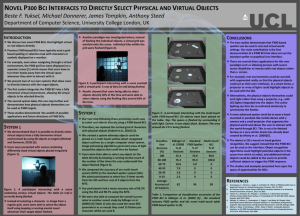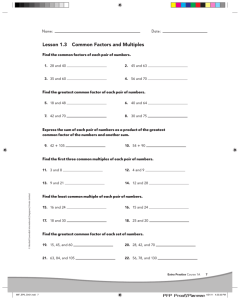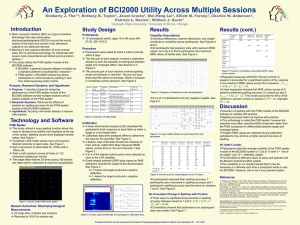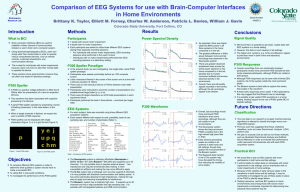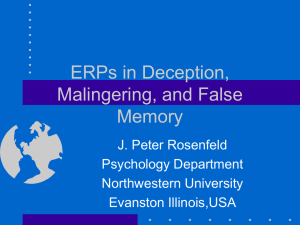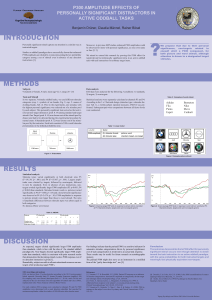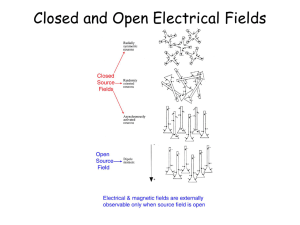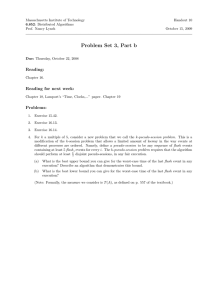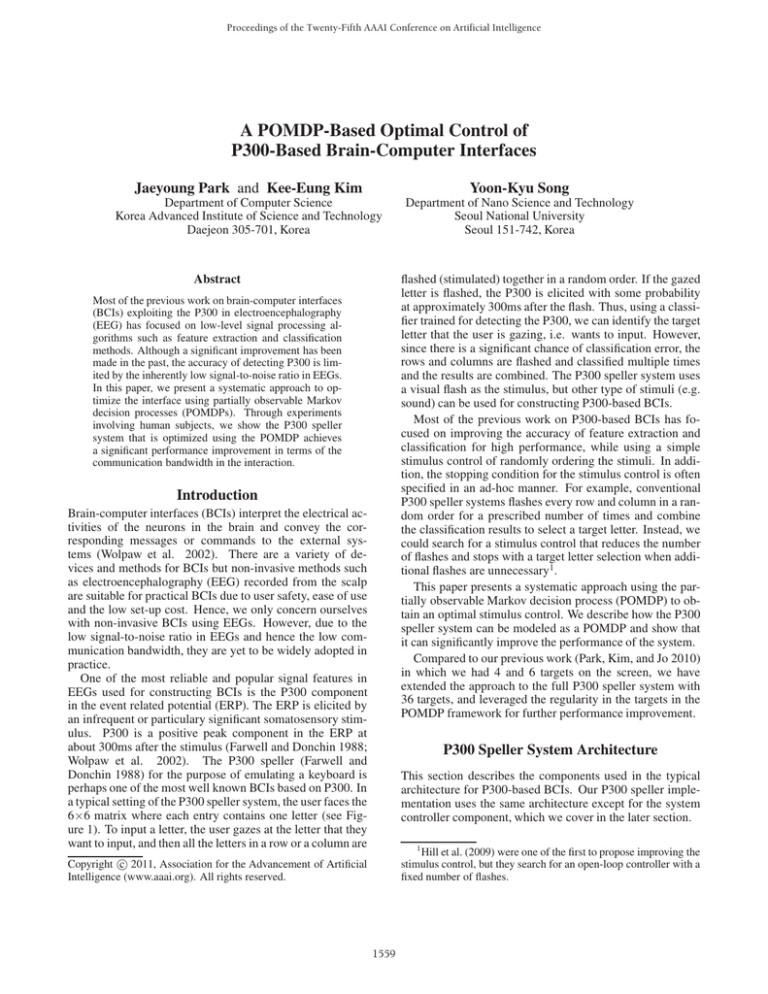
Proceedings of the Twenty-Fifth AAAI Conference on Artificial Intelligence
A POMDP-Based Optimal Control of
P300-Based Brain-Computer Interfaces
Jaeyoung Park and Kee-Eung Kim
Yoon-Kyu Song
Department of Computer Science
Korea Advanced Institute of Science and Technology
Daejeon 305-701, Korea
Department of Nano Science and Technology
Seoul National University
Seoul 151-742, Korea
flashed (stimulated) together in a random order. If the gazed
letter is flashed, the P300 is elicited with some probability
at approximately 300ms after the flash. Thus, using a classifier trained for detecting the P300, we can identify the target
letter that the user is gazing, i.e. wants to input. However,
since there is a significant chance of classification error, the
rows and columns are flashed and classified multiple times
and the results are combined. The P300 speller system uses
a visual flash as the stimulus, but other type of stimuli (e.g.
sound) can be used for constructing P300-based BCIs.
Most of the previous work on P300-based BCIs has focused on improving the accuracy of feature extraction and
classification for high performance, while using a simple
stimulus control of randomly ordering the stimuli. In addition, the stopping condition for the stimulus control is often
specified in an ad-hoc manner. For example, conventional
P300 speller systems flashes every row and column in a random order for a prescribed number of times and combine
the classification results to select a target letter. Instead, we
could search for a stimulus control that reduces the number
of flashes and stops with a target letter selection when additional flashes are unnecessary1.
This paper presents a systematic approach using the partially observable Markov decision process (POMDP) to obtain an optimal stimulus control. We describe how the P300
speller system can be modeled as a POMDP and show that
it can significantly improve the performance of the system.
Compared to our previous work (Park, Kim, and Jo 2010)
in which we had 4 and 6 targets on the screen, we have
extended the approach to the full P300 speller system with
36 targets, and leveraged the regularity in the targets in the
POMDP framework for further performance improvement.
Abstract
Most of the previous work on brain-computer interfaces
(BCIs) exploiting the P300 in electroencephalography
(EEG) has focused on low-level signal processing algorithms such as feature extraction and classification
methods. Although a significant improvement has been
made in the past, the accuracy of detecting P300 is limited by the inherently low signal-to-noise ratio in EEGs.
In this paper, we present a systematic approach to optimize the interface using partially observable Markov
decision processes (POMDPs). Through experiments
involving human subjects, we show the P300 speller
system that is optimized using the POMDP achieves
a significant performance improvement in terms of the
communication bandwidth in the interaction.
Introduction
Brain-computer interfaces (BCIs) interpret the electrical activities of the neurons in the brain and convey the corresponding messages or commands to the external systems (Wolpaw et al. 2002). There are a variety of devices and methods for BCIs but non-invasive methods such
as electroencephalography (EEG) recorded from the scalp
are suitable for practical BCIs due to user safety, ease of use
and the low set-up cost. Hence, we only concern ourselves
with non-invasive BCIs using EEGs. However, due to the
low signal-to-noise ratio in EEGs and hence the low communication bandwidth, they are yet to be widely adopted in
practice.
One of the most reliable and popular signal features in
EEGs used for constructing BCIs is the P300 component
in the event related potential (ERP). The ERP is elicited by
an infrequent or particulary significant somatosensory stimulus. P300 is a positive peak component in the ERP at
about 300ms after the stimulus (Farwell and Donchin 1988;
Wolpaw et al. 2002). The P300 speller (Farwell and
Donchin 1988) for the purpose of emulating a keyboard is
perhaps one of the most well known BCIs based on P300. In
a typical setting of the P300 speller system, the user faces the
6×6 matrix where each entry contains one letter (see Figure 1). To input a letter, the user gazes at the letter that they
want to input, and then all the letters in a row or a column are
P300 Speller System Architecture
This section describes the components used in the typical
architecture for P300-based BCIs. Our P300 speller implementation uses the same architecture except for the system
controller component, which we cover in the later section.
1
Hill et al. (2009) were one of the first to propose improving the
stimulus control, but they search for an open-loop controller with a
fixed number of flashes.
c 2011, Association for the Advancement of Artificial
Copyright Intelligence (www.aaai.org). All rights reserved.
1559
tial projection algorithm (Hoffmann, Vesin, and Ebrahimi
2006). We limited the maximum number of filters to 5 for
timely processing of data.
As for the classifier, we trained a support vector machine
on the preprocessed feature vectors using the LIBLINEAR
package (Fan et al. 2008). In order to obtain the likelihood
rather than the binary classification result, we used the L2regularized logistic regression.
Partially Observable
Markov Decision Processes (POMDPs)
A POMDP (Kaelbling, Littman, and Cassandra 1998) is a
mathematical model for sequential decision making problems under uncertainty in the observation. It is defined by an
8-tuple S, A, Z, b0 , T, O, R, γ: S is the set of environment
states; A is the set of actions; Z is the set of observations; b0
is the initial belief state where b0 (s) denotes the probability
a
that the initial state is s; Ts,s
is the transition probability of
a
changing the state from s to s by executing action a; Oz,s
is the observation probability of observing z when changing
to state s upon executing action a; Rsa is the reward in state
s by executing action a.
The belief state b in POMDP is defined to be the probability distribution over the current states. An optimal policy
π ∗ for the given POMDP model is the policy π : b → a
thatmaximizes the expected return (i.e. value), V π (b) =
∞
E[ t=0 γ t Rsatt |b, π], for all possible belief states.
Figure 1: The typical architecture of the P300-based BCI
systems. Our focus is concentrated on the system controller
component in improving the performance of the system. A
P300 speller matrix is depicted on the lower right corner.
Flash timing scheme
The timing of the flashes in the system follows the typical
scheme used in P300 speller systems: The user gazes at a
target letter that the user wants to input and all the letters
in a row and a column of the 6×6 matrix are flashed at the
same time, thus 6 letters flashed at a time. The flash interval
is 250ms, turning on the letters for 125ms and then turning
off for the remaining 125ms. We refer to a trial as the sequence of flashes until the system selects a target letter. A
pause interval of 2.5s is given between the trials. Each trial
is composed of a row trial immediately followed by a column trial. As can be inferred from their names, the row trial
consists of the sequence of flashes for identifying the row
that contains the target letter, and vice versa for the column
trial. The target letter is determined by the row and column
selected in the row and column trials.
Stimulus Control Methods
We describe three stimulus control methods used in the system controller. The first one, πrandom , is the conventional
stimulus control method used in practice. The others, πpomdp
and πbigram-pomdp , are the POMDP-based stimulus control
methods we propose in this paper.
Random control method: πrandom
This conventional control method uses a random sequence
of flashes in a trial. Every row and column is flashed a prescribed equal number of times. The row and column with
the maximum sum of the likelihood prediction values from
the classifier is selected as the target.
Data acquisition, preprocessing, and P300
classification
EEG signals were acquired by the Biopac MP 150 data acquisition system using 16 channels with 1kHz sampling rate.
We refer to an epoch of EEG signals corresponding to a
flash as the windowed signal data from 16 channels between
200ms and 450ms after the flash is given. This is because
P300 is expected to appear approximately at 300ms after the
stimulus.
The epoch data is then passed into the preprocessor to extract relevant features, and then passed to the classifier to
detect the existence of P300. In order to construct the preprocessor and the classifier, we first collected the training
data consisting of epoch instances each labeled either a target (i.e. an epoch of EEG signals after the flash on the target
letter) or a non-target.
As for the preprocessor, the raw epoch data were bandpass filtered (0.5-30Hz) and down-sampled to 100Hz. We
then extracted features from the training data using the spa-
POMDP control method: πpomdp
This control method is an optimal policy computed from
the POMDP modeling the P300 speller. Our approach constructs two POMDPs, one for the row trials and the other
for the column trials, which are almost identical. Below, we
describe the POMDP modeling for the row trials.
Suppose we have N =6 rows in the matrix. The states in
the POMDP correspond to potential target rows, hence there
are a total of N states. For each row in matrix, we can either flash it in the hope of eliciting P300 (N flash actions) or
claim that it’s the target row (N select actions), hence there
are a total of 2N actions. The output value from the P300
classifier serves as the observation, where the real value between 0 and 1 was discretized into intervals of size 0.1 (e.g.
z1 for the output value in [0.0, 0.1), z2 for the output value
1560
in [0.1, 0.2), etc.), hence there are a total of 10 observations.
Initial belief state is given as the uniform distribution and γ
is set to 0.99.
To make the system identify the target row as soon as possible, we give -1 reward for the flash actions. On the other
hand, to make the system identify the target row as accurately as possible, we give +10 for the select actions that
correctly select the target row, and -100 for the select actions
that incorrectly select the target row.
Transition probabilities for the flash actions are given as
the identity matrix assuming that the target does not change
within the trial. Those for the select actions are given as the
uniform distribution assuming that the target will randomly
change to a new one with equal probability.
The observation probabilities for the flash actions are estimated by constructing the histogram of classifier output values for each human subject from the training data. Although
simple, this approach may overfit the true observation probabilities, hence we mix (i.e. smooth out) the estimated oba
with the uniform distribution so
servation probabilities Ôz,s
a
a
= (1 − qo)Ôz,s
+ qo (1/N ), where qo is the mixing
that Oz,s
weight. In the experiments, we set qo to 0.3 for for all subjects. The observation probabilities for the select actions are
given as the uniform distribution since the classifier output
value does not contain any useful information.
bzat−d is the successor belief state of b after executing action
at−d and observing z. Note that the value function depends
on the belief state as well as the actions that were executed
within the delay window.
We extended the point-based value iteration (Pineau, Gordon, and Thrun 2006) to compute the optimal value function
and the optimal policy according to above definition. The
observation delay makes the dimension of the value function
much larger than the original value function. In other words,
we have to compute the optimal value function for every
delayed action sequence at−d , . . . , at−1 ∈ |A|d . However, noting that our POMDP model is symmetric (Doshi
and Roy 2008; Kim 2008), and we adopted the technique in
permutable POMDPs and extended it to handle observation
delays. Our POMDP algorithm implemented in Java solves
the model within a few minutes.
Experiments
Experimental setting
10 able-bodied students (7 male and 3 female students)
at Korea Advanced Institute of Science and Technology
(KAIST) participated in the experiment. The experiment
was approved by the KAIST Institutional Review Board (approval # KH2010-24).
Each subject went through 4 sessions in the experiment:
training, random, pomdp, and bigram-pomdp. In the training session, we collected the training data from 20 trials using the random control method πrandom . Each trial assigned a
random target letter. The trials used 10 flashes for each row
and column, hence there were a total of 120 row and column
flashes per trial. Once we collected the training data, we
obtained the preprocessor and P300 classifier. The observation probabilities in the POMDP were also computed for
each subject by constructing the histogram of classifier output values. Thus, using the control methods πrandom , πpomdp ,
and πbigram-pomdp obtained from the training data, we asked
the subject to input “MACHINE LEARNING” in each of
the remaining sessions.
Subjects A, C, E, G, and I went through the sessions in the
order of training, pomdp, bigram and random. On the other
hand, subjects B, D, F, H, and J went through the sessions
in the order of training, random, pomdp, and bigram. We
used two different setups because the random session takes
significantly more time than the pomdp or bigram sessions,
and we wanted to see whether the subject fatigue affected
performance.
We measured the performance in terms of accuracy and
practical bit rate. The accuracy is defined by the number of
correctly claimed letters over the number of total inputted
letters. The practical bit rate (Townsend et al. 2010) measures the quantity of the transferred information per unit
time, while taking into account the additional time required
to correct the error in the trials.
POMDP control method with bigram: πbigram-pomdp
This control method is basically the same as πpomdp , except
that the POMDP model uses the bigram prediction of the
target letters. Using the online text archive of novels, we
construct the bigram model of letters, and use the model to
compute the initial belief state for the current target row and
column given the previously selected target letter. In contrast, πpomdp starts from the uniform distribution.
Solving POMDP Model for P300 Speller
There are two constraints in computing an optimal policy
for the POMDP modeling the P300 speller system. First,
there is an observation delay for the flash actions since P300
appears 300ms after the flash. The epoch window starts
at 200ms and ends at 450ms, and a small amount of additional delay incurred by data processing and classification
makes the epoch data available shortly after 500ms. Since
the flash intervals are of 250ms, this implies that the observations are delayed for 2 time steps. Second, there is
a phenomenon known as repetition blindness (Fazel-Rezai
2007) which refers to the situation in which P300 may not be
elicited when a stimulus on the target is given again within
500ms.
We re-define the optimal value function to incorporate the
constraints above:
V ∗ (b, at−d , . . . , at−1 )
ai
at
= max st−d ,...,st b(st−d ) t−1
i=t−d Tsi ,si+1 Rst
at ∈A−A
+ γ z P r(z|b, at−d )V ∗ (bzat−d , at−d+1 , . . . , at ),
Results
Table 1 shows the performance of the πrandom , πpomdp , and
πbigram-pomdp . Since πrandom does not have a mechanism to
determine when to stop flashing, we report the performance
where d=2 is the number of time steps in the observation
delay, and A is the set of actions executed within 500ms.
1561
Subject
A
B
C
D
E
F
G
H
I
J
Avg.
s.d.
PBR
(bits/min)
36.483
9.541
4.051
0.447
6.765
17.720
1.057
9.080
16.331
20.592
12.206
10.968
πrandom
Acc.
(%)
100.00
100.00
81.25
56.25
87.50
100.00
62.50
81.25
87.50
93.75
85.625
15.604
#flashes
/target
24
120
120
120
96
60
120
48
48
36
-
PBR
(bits/min)
38.965
26.452
6.718
5.736
6.136
25.833
2.116
12.380
27.212
38.288
18.984
13.990
πpomdp
Acc.
(%)
100.00
100.00
87.50
81.25
87.50
100.00
75.00
93.75
100.00
100.00
92.5
0.092
#flashes
/target
21.9 ± 4.6
36.9 ± 13.8
96.8 ± 26.3
81.9 ± 24.7
106.9 ± 51.0
38.1 ± 9.6
164.5 ± 108.1
66.6 ± 17.4
35.6 ± 12.8
22.4 ± 4.8
-
PBR
(bits/min)
41.751
31.437
10.246
12.912
8.201
32.359
2.551
13.713
30.851
43.873
22.790
14.889
πbigram-pomdp
Acc.
#flashes
(%)
/target
100.00
19.8 ± 6.1
100.00
29.5 ± 7.9
100.00 111.1 ± 54.3
100.00
86.1 ± 72.4
93.75 105.6 ± 70.0
100.00
28.4 ± 5.8
81.25 196.6 ± 68.0
93.75
59.1 ± 22.7
100.00
30.3 ± 14.7
100.00
18.3 ± 7.5
96.875
0.061
-
Table 1: Experimental results of the three control methods. PBR stands for practical bit rate.
Acknowledgments
when the practical bit rate hits its maximum value. The
πrandom control used a maximum of 10 flashes for each row
and column, hence 120 is the maximum number of flashes
per target.
A one-way within-subject ANOVA test on the practical bit rate was conducted; Mauchly’s test indicated that
the sphericity assumption had been violated (p-value ≈
0.000 < 0.05), thus the degree of freedom was corrected according to the Greenhouse-Geisser estimates of the sphericity ( = 0.537). There was a significant difference among
the three control methods (F (1.073, 9.659) = 15.601,
p-value = 0.003 < 0.05). A post-hoc test using Bonferroni indicated that the πpomdp was significantly better than
the πrandom (p-value = 0.027 < 0.05). Also, πbigram-pomdp was
again significantly better than πpomdp (p-value = 0.001 <
0.05) as well as πrandom (p-value = 0.007 < 0.05).
In terms of the average practical bit rate, πpomdp
achieved a 55% performance improvement over πrandom , and
πbigram-pomdp achieved a 86% performance improvement over
πrandom and 20% over πpomdp .
The authors would like to thank Sungho Jo for providing the
EEG equipment and helpful comments for the early version
of the work. This work was supported by National Research
Foundation of Korea (grant # 2009-0069702) and KAISTMicrosoft Research Collaboration Center.
References
Doshi, F., and Roy, N. 2008. The permutable POMDP: fast solutions to POMDPs for preference elicitation. In Proc. of AAMAS.
Fan, R.-E.; Chang, K.-W.; Hsieh, C.-J.; Wang, X.-R.; and Lin, C.J. 2008. LIBLINEAR: A library for large linear classification. J.
of Machine Learning Research 9.
Farwell, L. A., and Donchin, E. 1988. Talking off the top of
your head: toward a mental prosthesis utilizing event-related brain
potentials. Electroencephalography and Clinical Neurophysiology
70.
Fazel-Rezai, R. 2007. Human error in P300 speller paradigm for
brain-computer interface. In Proc. of IEEE EMBS.
Hill, J.; Farquhar, J.; Martens, S.; Bießmann, F.; and Schölkopf, B.
2009. Effects of stimulus type and of error-correcting code design
on BCI speller performance. In Proc. of NIPS.
Hoffmann, U.; Vesin, J. M.; and Ebrahimi, T. 2006. Spatial filters
for the classification of event-related potentials. In Proc. of ESANN.
Kaelbling, L. P.; Littman, M. L.; and Cassandra, A. R. 1998. Planning and acting in partially observable stochastic domains. Artificial Intelligence 101.
Kim, K.-E. 2008. Exploiting symmetries in POMDPs for pointbased algorithms. In Proc. of AAAI.
Park, J.; Kim, K.-E.; and Jo, S. 2010. A POMDP approach to
P300-based brain-computer interfaces. In Proc. of ACM IUI.
Pineau, J.; Gordon, G.; and Thrun, S. 2006. Anytime point-based
approximations for large POMDPs. J. of Artificial Intelligence Research 27.
Townsend, G.; LaPallo, B. K.; Boulay, C. B.; Krusienski, D. J.;
Frye, G. E.; Hauser, C. K.; Schwartz, N. E.; Vaughan, T. M.; Wolpaw, J. R.; and Sellers, E. W. 2010. A novel P300-based braincomputer interface stimulus presentation paradigm: Moving beyond rows and columns. Clinical Neurophysiology 121.
Wolpaw, J. R.; Birbaumer, N.; McFarland, D. J.; Pfurtscheller, G.;
and Vaughan, T. M. 2002. Brain-computer interfaces for communication and control. Clinical neurophysiology 113.
Conclusion
We have present POMDP-based stimulus control methods
in the P300 speller system that significantly outperform the
conventional random control method. POMDP-based control methods achieve a high performance in the communication bandwidth by stimulating the rows and columns that
have high probability containing the target letter. In addition, POMDP-based control methods determine when to
stop and claim the target letter. In contrast, the conventional
random control method simply stimulate every row and column in a random order, and the stopping condition is typically implemented ad-hoc by the system expert, e.g., stimulating for a prescribed number of times.
Although we have described the POMDP approach to
the P300 speller system using visual stimulus, our work is
general enough to be applied to BCIs with other stimulus
paradigms such as auditory, olfactory, or even multi-modal
stimulus. It would be also possible to apply the approach to
newer state-of-art equipments such as fMRI or near-infrared
spectroscopy (NIRS).
1562

